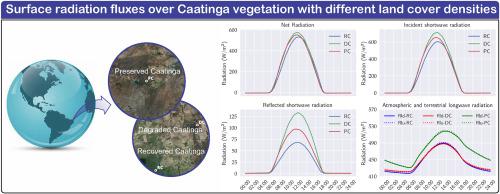当前位置:
X-MOL 学术
›
J. Arid Environ.
›
论文详情
Our official English website, www.x-mol.net, welcomes your feedback! (Note: you will need to create a separate account there.)
Analysis of surface radiation fluxes and environmental variables over Caatinga vegetation with different densities
Journal of Arid Environments ( IF 2.7 ) Pub Date : 2024-04-16 , DOI: 10.1016/j.jaridenv.2024.105163 Delson J.F. Silva , Tarciana R.B.F. Silva , Michele L. de Oliveira , Gabriel de Oliveira , Manoranjan Mishra , Celso Augusto Guimarães Santos , Richarde Marques da Silva , Carlos A.C. dos Santos
Journal of Arid Environments ( IF 2.7 ) Pub Date : 2024-04-16 , DOI: 10.1016/j.jaridenv.2024.105163 Delson J.F. Silva , Tarciana R.B.F. Silva , Michele L. de Oliveira , Gabriel de Oliveira , Manoranjan Mishra , Celso Augusto Guimarães Santos , Richarde Marques da Silva , Carlos A.C. dos Santos

|
The Caatinga biome, characterized by its dynamic vegetation due to climate and land use changes, experiences varied environmental responses during the dry and rainy seasons. This research aims to dissect the complexity of surface radiation fluxes, vapor pressure, and air and soil temperatures across three distinct vegetation densities within the Caatinga: recovering, degraded, and preserved. Utilizing data from Moderate Resolution Imaging Spectroradiometer/Enhanced Vegetation Index products to analyze these densities offers a novel lens through which to view the biome's reaction to climatic shifts. Our findings unveiled specific patterns of solar and longwave radiation fluxes that correlate with key climatic variables like air temperature and surface albedo. This investigation not only addresses a critical gap in our knowledge of a globally significant but underexplored biome, but it also advances our comprehension of how vegetation density influences radiation fluxes in arid settings. Insights from this study are vital for forecasting and mitigating the ecological and climatic impacts of land cover transformations in semiarid regions worldwide. Significantly, the degraded site displayed nearly double the solar radiation reflection (138 Wm) compared to the recovering site (68 Wm), underscoring the role of vegetation density in modulating local climate conditions, despite atmospheric consistency across the study sites.
中文翻译:

不同密度卡廷加植被表面辐射通量和环境变量分析
卡廷加生物群落的特点是植被因气候和土地利用变化而动态变化,在旱季和雨季经历不同的环境反应。这项研究旨在剖析卡廷加境内三种不同植被密度(恢复、退化和保存)的表面辐射通量、蒸气压以及空气和土壤温度的复杂性。利用中分辨率成像光谱仪/增强植被指数产品的数据来分析这些密度,为观察生物群落对气候变化的反应提供了一种新颖的视角。我们的研究结果揭示了与气温和地表反照率等关键气候变量相关的太阳和长波辐射通量的特定模式。这项研究不仅解决了我们对全球重要但尚未充分探索的生物群落的认识中的一个关键差距,而且还增进了我们对植被密度如何影响干旱环境中辐射通量的理解。这项研究的见解对于预测和减轻全球半干旱地区土地覆盖变化的生态和气候影响至关重要。值得注意的是,与恢复地点 (68 Wm) 相比,退化地点的太阳辐射反射 (138 Wm) 几乎是两倍,这强调了植被密度在调节当地气候条件方面的作用,尽管研究地点的大气一致性。
更新日期:2024-04-16
中文翻译:

不同密度卡廷加植被表面辐射通量和环境变量分析
卡廷加生物群落的特点是植被因气候和土地利用变化而动态变化,在旱季和雨季经历不同的环境反应。这项研究旨在剖析卡廷加境内三种不同植被密度(恢复、退化和保存)的表面辐射通量、蒸气压以及空气和土壤温度的复杂性。利用中分辨率成像光谱仪/增强植被指数产品的数据来分析这些密度,为观察生物群落对气候变化的反应提供了一种新颖的视角。我们的研究结果揭示了与气温和地表反照率等关键气候变量相关的太阳和长波辐射通量的特定模式。这项研究不仅解决了我们对全球重要但尚未充分探索的生物群落的认识中的一个关键差距,而且还增进了我们对植被密度如何影响干旱环境中辐射通量的理解。这项研究的见解对于预测和减轻全球半干旱地区土地覆盖变化的生态和气候影响至关重要。值得注意的是,与恢复地点 (68 Wm) 相比,退化地点的太阳辐射反射 (138 Wm) 几乎是两倍,这强调了植被密度在调节当地气候条件方面的作用,尽管研究地点的大气一致性。



























 京公网安备 11010802027423号
京公网安备 11010802027423号